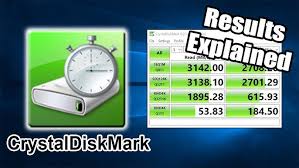Is CrystalDiskMark Reliable for SSD Benchmarks?

CrystalDiskMark has become a staple utility among tech enthusiasts, system builders, and storage testers. Known for its simplicity and clarity, it benchmarks storage devices like SSDs, HDDs, and USB drives. But the question remains—can you genuinely trust it to deliver reliable SSD benchmark results?
To answer this, it’s essential to understand what CrystalDiskMark does, how it works under the hood, its limitations, and how well it reflects real-world performance. This article examines the reliability of CrystalDiskMark as an SSD benchmarking tool in depth.
Overview of CrystalDiskMark
CrystalDiskMark is a free and open-source utility developed by Crystal Dew World. It performs read and write speed tests using various file sizes and patterns to provide users with a quick snapshot of their drive’s performance. The results are typically displayed in megabytes per second (MB/s) for sequential and random read/write operations.
What makes CrystalDiskMark popular is its user-friendly interface, quick results, and customizable test profiles. Whether testing a blazing-fast NVMe SSD or a budget SATA SSD, the tool provides a uniform testing platform that’s easy to use—even for non-technical users.
How CrystalDiskMark Measures Performance
At its core, CrystalDiskMark simulates various types of data operations to measure how a drive performs in different scenarios. The key metrics it presents include:
- Sequential Read/Write (Q8T1 and Q1T1): Measures performance when reading or writing large files in a linear fashion.
- Random Read/Write (4KiB Q32T16, Q1T1): Gauges speed for small, scattered files—critical for OS operations.
- IOPS (Input/Output Operations per Second): Useful for enterprise-level or server applications.
The tool uses test patterns such as:
- Default (random data) for realistic load.
- Zero fill or 1 fill for synthetic maximum throughput testing.
These options allow users to stress-test drives in various ways and compare performance across different conditions.
Strengths of CrystalDiskMark
Widely Accepted in the Industry
CrystalDiskMark has become the go-to benchmarking utility, especially in reviews and product comparisons. Tech websites, YouTube channels, and even SSD manufacturers often rely on its results. Its popularity means users can find a lot of reference data for comparison.
Transparent and Customizable Testing
The tool lets users select test sizes (from 50MB to 64GB), the number of test runs, and whether to use random or zero-filled data. This helps in tailoring tests to the intended use-case of the drive—whether for gaming, enterprise, or general computing.
Lightweight and Fast
Compared to enterprise-grade tools like ATTO or Anvil, CrystalDiskMark is lightweight, easy to install, and fast to execute. Even beginners can get meaningful results in minutes.
Limitations of CrystalDiskMark
Synthetic vs. Real-World Performance
CrystalDiskMark tests are synthetic, which means they simulate workloads in a controlled manner. While this helps in achieving repeatability, it doesn’t always reflect real-world use.
For example, writing a large sequential file might show 500 MB/s in CrystalDiskMark, but real-world application installations or game loads might feel slower due to background processes, system cache, or thermal throttling.
Lack of Endurance and Latency Metrics
Reliability isn’t just about speed—it’s also about how consistently a drive performs over time. CrystalDiskMark doesn’t test SSD endurance, thermal behavior, or long-term sustained write performance. It also doesn’t report latency in a granular fashion, which is essential for high-performance scenarios like databases or virtualization.
No System-Wide Context
CrystalDiskMark tests storage in isolation. It doesn’t consider CPU bottlenecks, memory constraints, or OS-level caching. So, a high benchmark score doesn’t guarantee a responsive system if the rest of the hardware isn’t up to par.
Comparison with Other Benchmarking Tools
ATTO Disk Benchmark
ATTO is a long-standing benchmarking tool known for its depth and granularity. It excels in showing performance variation across different block sizes. While CrystalDiskMark is more visual and user-friendly, ATTO provides more detailed insights, especially useful for professionals.
AS SSD Benchmark
AS SSD is another synthetic tool that focuses on access time and compression performance. It also calculates a score for comparison. It complements CrystalDiskMark well by adding latency insights and compression-based testing, which is important for drives with controllers that use compression to speed up writes.
Anvil’s Storage Utilities
Anvil’s tool offers an even more in-depth look at SSD performance, including detailed IOPS, response times, and endurance simulation. It’s heavier but gives a broader performance picture than CrystalDiskMark alone.
Use Cases Where CrystalDiskMark Shines
Quick Diagnostic Checks
For users wanting to confirm that their SSD performs close to manufacturer specs, CrystalDiskMark is ideal. It can quickly show if a drive is underperforming due to a driver issue, firmware bug, or system misconfiguration.
Drive Comparison Before Purchase
Before buying an SSD, many users check review results based on CrystalDiskMark. This helps in understanding the relative speed differences between budget, mid-range, and premium models.
Evaluating USB or External Drives
CrystalDiskMark is effective in testing USB 3.0, 3.1, or even Thunderbolt-based external SSDs and flash drives. This helps in validating claims made by external storage manufacturers.
Real-World Testing Recommendations
To get more reliable results, follow best practices when using CrystalDiskMark:
- Close background apps – Ensure the system isn’t using the drive during testing.
- Disable antivirus temporarily – Security software can interfere with read/write speeds.
- Use default settings – Unless testing for a specific scenario, stick with default queue depth and thread count.
- Repeat tests – Run multiple iterations and average results for consistency.
- Test with full and near-empty drives – SSDs behave differently when nearing capacity due to how flash memory is managed.
What Experts Say About Reliability
Experts generally agree that CrystalDiskMark is reliable for snapshot benchmarking. Its results are repeatable and valid within its scope—meaning it’s great for initial diagnostics, comparisons, and surface-level performance validation.
However, for tasks that demand deep-level benchmarking, including sustained write testing, endurance analysis, or data compression impacts, complementary tools should be used alongside CrystalDiskMark.
Interpreting Results with Caution
It’s easy to be impressed by large MB/s numbers, but interpreting these results requires context:
- A high sequential read speed benefits video editing or large file transfers.
- Strong random 4K read/write performance is more relevant for operating systems and applications.
- Poor Q1T1 performance (queue depth 1, thread 1) may indicate slow single-thread responsiveness.
Always align the test pattern with the intended workload. A gaming laptop and a database server require very different performance profiles.
Conclusion
CrystalDiskMark stands out as a fast, lightweight, and widely trusted SSD benchmarking tool. While it doesn’t paint the full picture of drive health or real-world performance, it provides a highly reliable indicator of synthetic read/write speed.
When used correctly—and interpreted with context—it proves to be a valuable part of any storage benchmarking toolkit. Whether building a gaming PC, upgrading a laptop, or testing a new NVMe SSD, CrystalDiskMark gives you a clear, consistent snapshot that helps make better hardware decisions.




